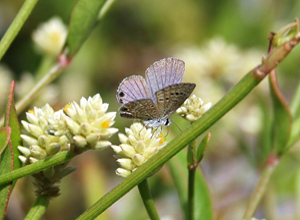|
Do you see/hear...?
|
| Activity
|
Adults
One or more adults are seen or heard moving about or at rest.
More...
For abundance, enter the number of individual animals observed in this phenophase.
|
|
|
Adults feeding
One or more adults are seen feeding with their straw-like tongue (proboscis). If possible, record the substance and species on which they are feeding (for example, nectar, sap, dung, or moist soil) in the comments field. For Echinargus isola, adults feed on the flower nectar of many different plant species.
For abundance, enter the number of individual animals observed in this phenophase.
|
|
|
Flower visitation
One or more individuals are seen visiting flowers or flying from flower to flower. If possible, record the name of the plant or describe it in the comments field.
For abundance, enter the number of individual animals observed in this phenophase.
|
|
|
Migrating adults
Multiple adults of the same species are seen flying steadily in a uniform direction without stopping.
More...
For abundance, enter the number of individual animals observed in this phenophase.
|
| Reproduction
|
Mating
A male and female are seen coupled in a mating position, usually end to end. This can occur at rest or in flight.
For abundance, enter the number of individual animals observed in this phenophase.
|
|
|
Egg laying
A female is seen laying eggs on a plant or other surface. If possible, record the name of the plant or describe it in the comments field. For Echinargus isola, eggs are typically deposited on the flower buds of plants in the pea family (Fabaceae).
For abundance, enter the number of individual animals observed in this phenophase.
|
|
|
Eggs
One or more eggs are seen on a plant or other surface. If possible, record the name of the plant or describe it in the comments field. For Echinargus isola, the tiny, pincushion-shaped, pale green eggs are covered in raised white points, and are typically found on the flower buds of plants in the pea family (Fabaceae).
For abundance, enter the number of individual animals observed in this phenophase.
|
| Development
|
Caterpillars
One or more caterpillars (larvae) are seen moving about or at rest. When seen on a plant, if possible, record the name of the plant or describe it in the comments field. For Echinargus isola, caterpillars have a wide, hairy body and start out off-white in color, then depending on the flowers they are eating, develop green, brown, pink, red or other color chevron markings down their back.
For abundance, enter the number of individual animals observed in this phenophase.
|
|
|
Caterpillars feeding
One or more caterpillars are seen feeding. If possible, record the name of the species or substance being eaten or describe it in the comments field. For Echinargus isola, caterpillars typically feed on the flowers, fruits and sometimes leaves of plants in the pea family (Fabaceae).
For abundance, enter the number of individual animals observed in this phenophase.
|
|
|
Pupae
One or more pupae are seen in a cocoon or shell (puparium). For Echinargus isola, pupae are enclosed in a smooth, ovoid, green or light brown, translucent shell (chrysalis) that appears darker as the butterfly develops, and are typically found on or near a host plant in the pea family (Fabaceae). Do not include empty pupal shells after the adult has emerged from them.
For abundance, enter the number of individual animals observed in this phenophase.
|
|
|
Dead adults
One or more dead adults are seen.
For abundance, enter the number of individual animals observed in this phenophase.
|
|
|
Dead caterpillars
One or more dead caterpillars are seen.
For abundance, enter the number of individual animals observed in this phenophase.
|
| Method
|
Individuals at a feeding station
One or more individuals are seen visiting a feeder, feeding station, or food placed by a person.
For abundance, enter the number of individual animals observed in this phenophase.
|
|
|
Individuals in a net
One or more individuals are seen caught in a net.
For abundance, enter the number of individual animals observed in this phenophase.
|
|
|
Individuals in a trap
One or more individuals are seen caught in a trap.
For abundance, enter the number of individual animals observed in this phenophase.
|
